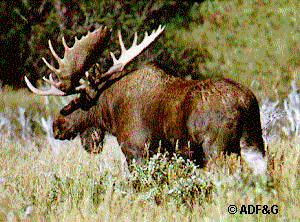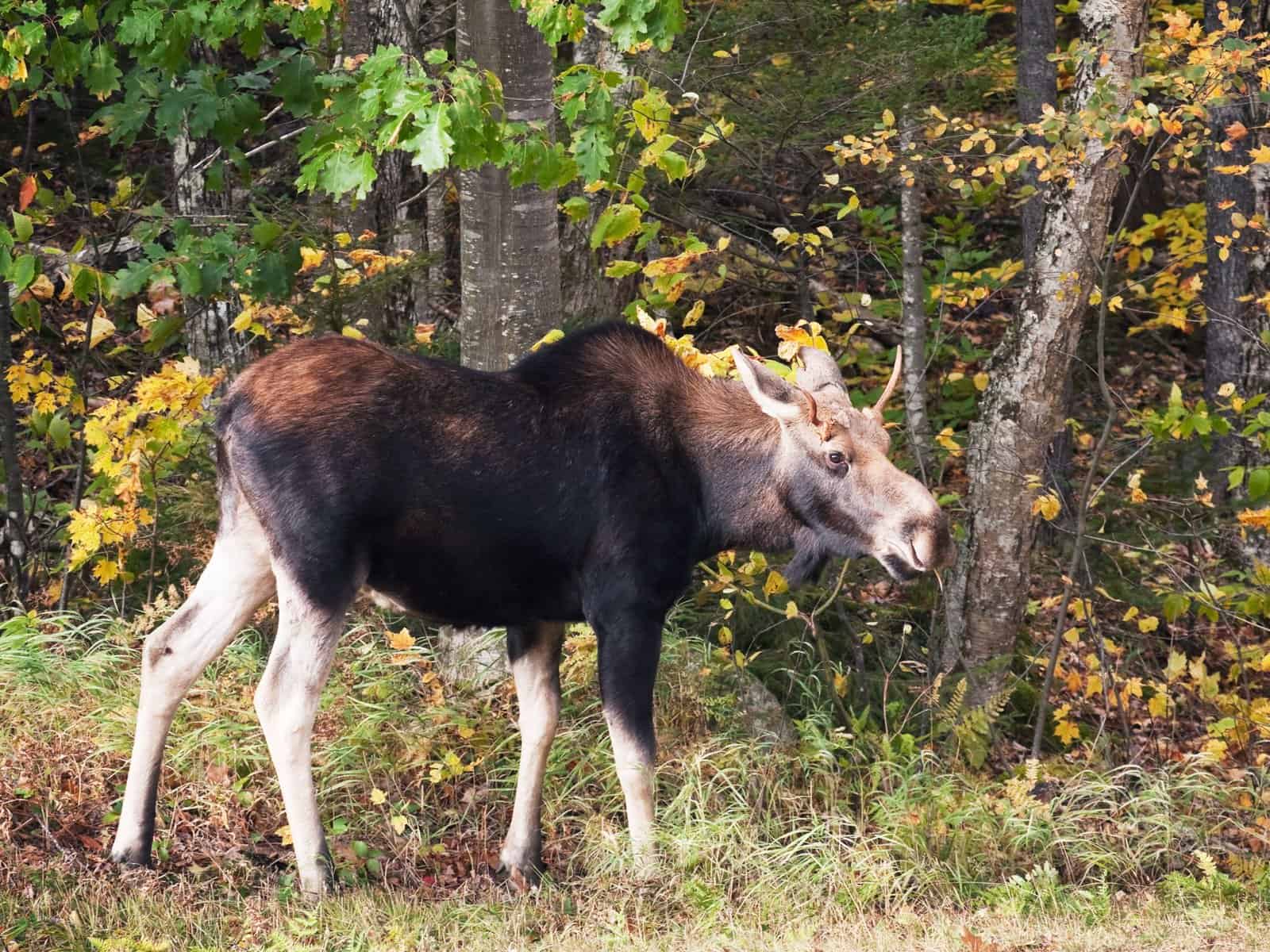Moose live in forests across North America, Europe, and Asia, preferring areas with abundant vegetation near water sources. They are commonly found in boreal and temperate forests.
Moose habitats typically include dense forests, marshy areas, and lakeshores. These majestic creatures are well adapted to cold climates and thrive in regions with ample food and suitable shelter. The large size and unique antlers of moose make them an iconic symbol of the wilderness.
Their presence in these diverse ecosystems contributes to the biodiversity and balance of their natural habitats. Despite their size, moose are elusive animals and are known for their solitary nature, only coming together during the mating season.
Moose Habitat
Geographical Distribution
Moose are primarily found in North America, Europe, and Asia.
Preferred Ecosystems
In North America, moose thrive in forests, wetlands, and mountainous areas.

Credit: www.homeralaska.org
Adaptations
Moose are well-adapted to their environment, possessing unique physical attributes and behavioral patterns that help them thrive.
Physical Attributes
- Moose have a large body size with a distinctive hump on their shoulders.
- Their long legs allow them to navigate through thick vegetation and deep snow.
- Antlers, found only in males, are used for display and combat during mating season.
Behavioral Patterns
- Moose are primarily herbivores, feeding on aquatic plants, twigs, and leaves.
- They are solitary animals, except during the mating season.
- Moose are excellent swimmers and can dive underwater to forage for plants.
Interaction With Other Species
Moose are a vital part of their ecosystems and interact with various other species within their habitats. Understanding these interactions sheds light on the complex web of relationships in the natural world.
Predator-prey Dynamics
Within their range, moose contend with several predators, including wolves, bears, and cougars. Moose calves can fall prey to these predators, but adult moose are formidable adversaries. Their size and strength serve as a deterrent to many would-be predators, and they can defend themselves and their offspring with their sharp hooves and powerful kicks.
Ecological Relationships
Moose play an essential role in shaping their environment. Their foraging habits influence plant communities, and they are known as keystone herbivores. By browsing on trees and shrubs, moose create open areas for smaller browsing animals and impact the structure of forests.

Credit: www.pewtrusts.org
Human Impact
The presence of humans has had a significant impact on moose populations and their habitats. Here, we will explore two major ways in which human activities have affected these magnificent creatures: hunting and conservation, as well as urban encroachment.
Hunting And Conservation
Hunting has been a longstanding tradition in many cultures around the world. While hunting can be done sustainably and in accordance with conservation efforts, the unregulated and excessive hunting of moose has had detrimental effects on their populations in certain regions.
Fortunately, there have been significant efforts made to promote responsible hunting practices and conservation measures for moose populations. These efforts aim to strike a balance between satisfying the hunting desires of individuals and ensuring the long-term survival of moose species. One example of such effort is the establishment of hunting seasons and quotas, which restrict the number of moose that can be hunted within a certain timeframe. This allows the moose population to reproduce and replenish itself, ensuring their continued existence.
Urban Encroachment
As human civilization continues to expand and urbanize, it often encroaches upon the natural habitats of various wildlife species, including moose. Urban encroachment involves the conversion of wilderness areas into urban landscapes, resulting in habitat loss and fragmentation for moose and other wildlife.
Moose require large areas of forested habitats for food, shelter, and mating. When urban areas spread into these habitats, the natural processes that moose rely on for their survival are disrupted. Deforestation and the construction of buildings, roads, and infrastructure not only destroy critical moose habitat but also disrupt their migration routes and natural behavior patterns.
To mitigate the negative impacts of urban encroachment on moose populations, various strategies have been implemented. These include the creation of wildlife corridors, which provide safe passage for moose as they move across fragmented landscapes, and the establishment of protected areas and nature reserves to preserve vital habitats.
Future Prospects
As climate change continues to reshape our planet, it is crucial to examine how these alterations affect the habitat and future prospects of the moose population. In this section, we will explore the climate change effects on moose, as well as the ongoing conservation efforts to safeguard their existence.
Climate Change Effects
The warming climate poses significant challenges for moose, impacting both their physical and ecological well-being. Rising temperatures can lead to the spread of diseases and parasites, such as ticks and brainworm, which can be harmful to moose populations. Moreover, changing precipitation patterns, including increased rainfall and shorter winters, can disrupt the moose’s access to food sources and affect their reproduction cycles.
The reduction in suitable habitat is another consequence of climate change. Moose, being a cold-adapted species, rely on boreal and sub-boreal forests for shelter and sustenance. Unfortunately, as temperatures rise, these forests are transforming, and crucial plant species like specific types of shrubs and trees are disappearing. For instance, the decline in the availability of aquatic vegetation, a vital food source for moose, can lead to malnutrition and ultimately impact their survival.
| Climate Change Effects on Moose: | Consequences: |
|---|---|
| Spread of diseases and parasites | Health risks and population decline |
| Disrupted access to food sources | Nutritional stress and reproductive challenges |
| Reduced suitable habitat | Inadequate shelter and food availability |
Conservation Efforts
Given the alarming effects of climate change on moose, conservation efforts have become integral for their survival. These initiatives aim to mitigate habitat loss, prevent disease outbreaks, and promote sustainable management practices.
One notable conservation effort is the protection and restoration of suitable moose habitats. This involves identifying key areas and implementing measures to conserve their biodiversity and prevent further degradation. Additionally, organizations work to connect fragmented landscapes, allowing for movement and gene flow among moose populations.
Collaboration between wildlife organizations, researchers, and policymakers is essential in the fight to conserve moose populations. By conducting studies and monitoring the impacts of climate change on these majestic creatures, valuable data is obtained. This data helps inform policy decisions and promote adaptive management strategies, ensuring the long-term survival of moose.
- Protecting and restoring moose habitats
- Promoting biodiversity conservation
- Connecting fragmented landscapes
- Conducting research and data analysis
- Informing policy decisions

Credit: www.adfg.alaska.gov
Frequently Asked Questions On Moose Where Do They Live
Where Do Moose Live In North America?
Moose are commonly found in the northern regions of North America, particularly in areas with dense forests and wetlands. They can be spotted in regions such as Alaska, Canada, and parts of the northern United States.
What Is The Natural Habitat Of Moose?
The natural habitat of moose consists of boreal and temperate forests, swamps, and marshy areas. They thrive in areas with an abundance of vegetation, such as willow, birch, and aquatic plants. These habitats provide them with both food and shelter.
Do Moose Live In The Tundra?
Moose generally prefer forested habitats, but they can also be seen in some tundra regions. In areas where forests are limited or absent, moose adapt to living in shrubby and open tundra landscapes. They seek out areas with adequate food sources and protection from predators.
Conclusion
Moose are predominantly found in North America. Their habitats include forests, wetlands, and meadows. Understanding their preferred environments and behavior patterns is essential for conservation efforts. By spreading awareness about their habitats, we can work towards ensuring the preservation of these majestic creatures for future generations to cherish and admire.



